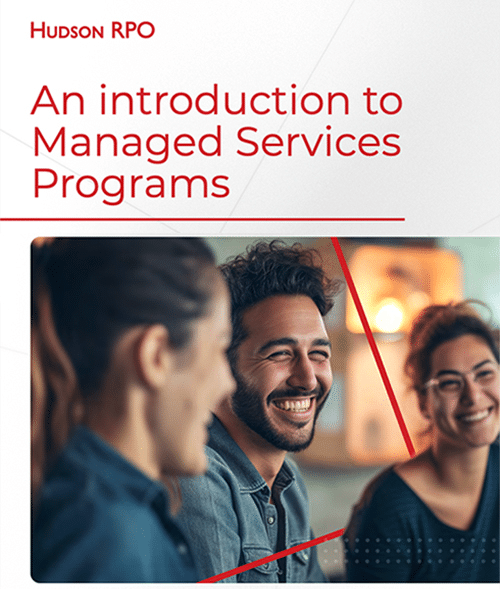- Blogs & Articles
Weighing outsourced recruitment, versus in-house or blended models
Outsourced recruitment vs. in-house recruitment, or indeed even a blend of both: what makes the best sense for your business?
In some cases, the answer lies somewhere in between, via a blended talent model.
There isn’t one right answer. What we can probably all agree on, however, is that attracting the best talent certainly requires an agile approach.
Recruitment must be as flexible as any other business function, if not more so.

Perhaps your business has found itself at a hiring crossroads. Or, perhaps HR is undertaking a cyclical review of the wider talent acquisition and management functions.
Notably, more business leaders are incorporating outsourced recruitment (also known as recruitment process outsourcing, or RPO) into their talent strategy. The global RPO market is expected to produce a compounded annual growth rate (CAGR) of 29.1% from 2019-2027, according to industry reports. (See note 1.)
Market trends are worth considering. But, on a more local level, how do you know whether outsourced recruitment could benefit your talent strategy?
We’d like to help you launch a healthy conversation with your fellow business partners. Let’s start with something relatively simple, a snapshot of the conditions that can help justify each talent strategy:
Outsourced recruitment (RPO)
- Hiring niche roles beyond the core competency of your business
- Moving into new global territories
- High agency costs because of low retention
- Facing compliance issues
- Sudden, high-volume hiring
- Recruitment tech implementation challenges
In-house
- Steady recruiting needs across your organization
- Primarily recruiting for roles in your company’s wheelhouse
- Sudden recruiting demands don’t disrupt essential HR functions
- Geographically contained hiring
Blended (RPO and in-house)
- Short-term volume hiring to launch a new location
- New hiring projects that disrupt HR’s daily activities
- Growing use of a contingent workforce
- Compliance knowledge shortfall
- Recruiting for a mission-critical job category is falling behind (sourcing can help)
- Need to re-envision your employer brand
- Existing in-house team or RPO partner lacks industry expertise for role category
Evaluating outsourced recruitment and all options
Of course, the line between each of these models is dotted. They’re never hard and fast.
Best practice reveals that the ability to pivot between them at any point is essential. And, from what we see, the most powerful recruitment benefits from open collaboration across your business and often between multiple providers.
In today’s fast-changing marketplace, many companies are re-envisioning their talent strategy. There are many reasons for this, from the rise of remote working to the proliferation of uncertain political environments.
When it comes to designing a talent strategy that suits your long-term goals while meeting your current needs, the best path forward isn’t always obvious.
Outsourced recruitment, in-house recruitment, or a blended strategy?
What works for one enterprise, may not suit another.
There will be many internal and market-wide factors to consider. The decision will ultimately depend on much more than a snapshot list of factors, but the bullet points can help spark a healthy debate with business stakeholders.
Want more insights on how to evaluate talent models? Be sure to read Mark Rogers’ views on how to select the best talent delivery model. With a track record that includes client-side recruitment, Mark knows well what it’s like to sit in the HR decision-maker’s hot seat!
Notes
1.) The Insight Partners: Recruitment Process Outsourcing Market to 2027 – Global Analysis and Forecasts by Type and Industry. Accessed 20 August 2019. https://www.researchandmarkets.com/reports/4762285/recruitment-process-outsourcing-market-to-2027

Hudson RPO
Content Team
The Hudson RPO Content Team is made up of experts within the Talent Acquisition industry across the Americas, EMEA and APAC regions. They provide educational and critical business insights in the form of research reports, articles, news, videos, podcasts, and more. The team ensures high-quality content that helps all readers make talent decisions with confidence.
Sign up to receive the latest recruitment insights and Hudson RPO news.





















